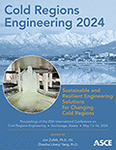Alaskan Pavement Resilience: Navigating Climate Change in Cold Regions
Publication: Cold Regions Engineering 2024: Sustainable and Resilient Engineering Solutions for Changing Cold Regions
ABSTRACT
The global phenomenon of climate change has led to significant environmental transformations, particularly affecting cold regions due to their extreme temperature dynamics. Among the critical elements facing the consequences of climate change in these regions are pavement structures, essential components of roadway, and airport infrastructure. This study explores the repercussions of climate change on pavement structures within cold regions, focusing specifically on shifts in temperature patterns and, subsequently, frost depth. Through the analysis of temperature records, this research investigates the annual average temperatures, emphasizing trends spanning multiple decades. Complementary to this, freezing degree day data are utilized to compute frost penetration depths and establish average trends over the same extended timeframe. By comparing three prominent Alaskan regions in terms of both temperature variations and frost penetration, the study aims to discern the direct implications of climate change. The regression analysis reveals noteworthy statistical changes in frost penetration depths across all studied locations. Projecting from current trends, future estimates for frost penetration indicate potential variations of around 15 cm over a 40-year period, contingent on the region. This study not only investigates if tangible effects of climate change on pavement structures exist but also offers valuable insights into potential long-term consequences for infrastructure in cold regions.
Get full access to this chapter
View all available purchase options and get full access to this chapter.
REFERENCES
Alaska Department of Transportation and Public Facilities. (2020). Alaska Flexible Pavement Design Manual. Version 2.
Alaska Department of Transportation and Public Facilities, “Department Fast Facts: Prepared for Legislative Session 2022”, https://dot.alaska.gov/comm/legislative/docs/Fact-Sheet.pdf
Alaska Department of Transportation and Public Facilities. DOT&PF Regions Map. Retrieved January 2023, from https://dot.alaska.gov/regions-portal.shtml.
Eyring, V., Bony, S., Meehl, G.A., Senior, C.A., Stevens, B., Stouffer, R.J., and Taylor, K.E. (2016). Overview of the coupled model intercomparison project phase 6 (CMIP6) experimental design and organization. Geoscientific Model Development, 9(5),1937–1958.
IPCC, 2018: Summary for Policymakers. In: Global Warming of 1.5°C. An IPCC Special Report on the impacts of global warming of 1.5°C above pre-industrial levels and related global greenhouse gas emission pathways, in the context of strengthening the global response to the threat of climate change, sustainable development, and efforts to eradicate poverty Writing Team, Masson-Delmotte, V., Zhai, P., Pörtner, H.-O., Roberts, D., Skea, J., Shukla, P.R., Pirani, A., Moufouma-Okia, W., Péan, C., Pidcock, R., Connors, S., Matthews, J.B.R., Chen, Y., Zhou, X., Gomis, M.I., Lonnoy, E., Maycock, T., Tignor, M., and Waterfield, T. Cambridge University Press, Cambridge, UK and New York, NY, USA, pp. 3-24,.
Lang, R. (n.d.). Freezing Degree Days. Anchorage. Retrieved January 2022.
Larson, P.H., Goldsmith, S., Smith, O., Wilson, M.L., Strzepek, K., Chinowsky, P., and Sayor, B. (2008). “Estimating future costs for Alaska public infrastructure at risk from climate change,” Global Environmental Change, Vol 18, Issue 3 pp. 442–457.
National Cooperative Highway Research Program, Burbank, C. J., and Brinckerhoff, P. (2009). 20-24(59) Strategies for Reducing the Impacts of Surface Transportation on Global Climate Change. Washington, D.C.
National Cooperative Highway Research Program, Meyer, M. D., Flood, M. (2015). 25-25(94) Integrating Extreme Weather into Transportation Asset Management Plans. Washington, D.C.
National Oceanic Atmospheric Administration. Retrieved March 26, 2022, from https://www.ncei.noaa.gov/access/search/data-search/daily-summaries.
Piryonesi, S.M., and El-Diraby, T. (2021). “Climate change impact on infrastructure: A machine learning solution for predicting pavement condition index,” Construction and Building Materials, Vol. 306, Article 124905.
Qiao, Y., Dawson, A.R., Parry, T., Flintsch, G., and Wang, W. (2020). “Flexible Pavements and Climate Change: A Comprehensive Review and Implications,” Sustainability. 12(3):1057.
Simonsen, E., Janoo, V.C., and Isacsson, U. (2002). “Resilient Properties of Unbound Road Materials during Seasonal Frost Conditions,” Journal of Cold Regions Engineering, Vol 16, Issue 1.
Soliman, H., Kass, S., and Fleury, N. (2008). Annual Conference of the Transportation Association of Canada. A Simplified Model to Predict Frost Penetration for Manitoba Soils. Toronto.
Stewart, B.C., Kunkel, K.E., Champion, S.M., Frankson, R., Stevens, L.E., Wendler, G., Simonson, J., and Stuefer, M. (2022). Alaska State Climate Summary 2022. NOAA Technical Report NESDIS 150-AK. NOAA/NESDIS, Silver Spring, MD, 6 pp.
Stern, D.I., and Kaufmann, R.K. (2014). Anthropogenic and natural causes of climate change. Climatic Change 122, 257–269.
Information & Authors
Information
Published In
History
Published online: May 9, 2024
ASCE Technical Topics:
- Air transportation
- Airport and airfield pavements
- Airports and airfields
- Climate change
- Climates
- Cold regions
- Cold regions engineering
- Engineering fundamentals
- Engineering mechanics
- Environmental engineering
- Frost
- Infrastructure
- Material mechanics
- Material properties
- Materials engineering
- Measurement (by type)
- Pavements
- Structural engineering
- Structural members
- Structural systems
- Temperature (by type)
- Temperature effects
- Temperature measurement
- Thermal properties
- Thermodynamics
- Transportation engineering
Authors
Metrics & Citations
Metrics
Citations
Download citation
If you have the appropriate software installed, you can download article citation data to the citation manager of your choice. Simply select your manager software from the list below and click Download.
